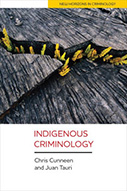Indigenous Criminology

Authors: Chris Cunneen and Juan Tauri
Publisher: Bristol, UK: Policy Press; Chicago: University of Chicago Press, 2017. 206p.
Reviewer: Jeremy Patzer | March 2018
Indigenous Criminology, as its title would suggest, is a book that seeks to contribute to the forging of a new criminological sub-discipline. It is both international in scope and relatively concise, with its eight chapters (excluding references and index) taking up well under two hundred pages. Its purview is limited to the common law settler states of the United States, Canada, Australia, and New Zealand. (Limiting the comparative aspect of the book to countries with certain foundational commonalities is no doubt one of the reasons why Chris Cunneen and Juan Tuari were able to keep the work at such a manageable length.) Through those eight chapters, the authors endeavour to “provide the basis for a new explanatory model for understanding Indigenous peoples’ contact with the criminal justice system”—one that argues “for the importance of Indigenous methodologies and the prioritisation of Indigenous voices in understanding contemporary problems” (page 1).
The introduction presents a brief portrait of the Indigenous peoples living within the four countries, the challenges they face in terms of a variety of social indicators, and a sketch of the varying regimes of legal-political recognition of Indigenous self-determination and rights within each jurisdiction. It also sets out some theoretical groundwork, largely comprising several fundamental assertions which resurface regularly throughout the book, especially in chapters two and three. Among these are the desire “to affirm the validity of Indigenous knowledge in understanding crime and social harm,” to critique the re-emerging influence of what they call “administrative” or “authoritarian” criminologies, and to argue that settler colonialism and its criminogenic effects are too often elided in these conventional criminological frameworks (page 23). The authors advocate for the utility of theoretical approaches such as Critical Race Theory and methodologies such as Participatory Action Research in advancing the project of an Indigenous criminology. Chapter four looks at a number of contemporary issues related to policing and makes the central argument that, despite the formal racially neutral character of contemporary policing, it is still fundamental to the reproduction of colonial relations. In chapter five the authors mobilize an intersectional analysis to highlight the rapidly increasing over-representation of Indigenous women, their high rates of victimization, and their experience of invasive crime control measures, while also being excluded or ignored in the development of crime control policies. Chapter six looks at the issues of sentencing and punishment, chapter seven at the expansion of global markets for crime control policies and interventions (e.g. Family Group Conferencing originating from New Zealand) and its effect on Indigenous peoples, and chapter eight offers a final synthesis on “Critical issues in the development of an Indigenous criminology.”
Given the book’s ambitions and its modest length, Cunneen and Tauri have invariably had to make a number of choices. U.S. tribal police and tribal courts receive special mention when examining the issues of policing and sentencing in their respective chapters, but in general certain topics invite primary focus on one or two examples from select jurisdictions.
Indigenous Criminology offers a useful introduction to many critical criminological issues facing Indigenous peoples within common law settler state contexts. It can be of value to those instructors who may wish to place local or national Indigenous issues in an international context—albeit one limited to former British colonies. As always, theoretical and methodological preferences may differ, but Cunneen and Tauri can be commended for their ambition to put paper to the idea of an Indigenous criminology and helping to catalyze further research and international exchange in this area.
Jeremy Patzer, Department of Sociology, University of Manitoba


